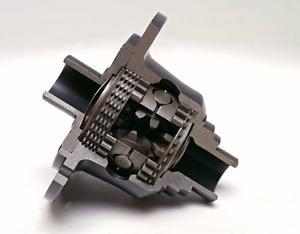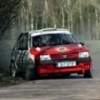
Two common types of aftermarket differential are the plate-type diff (examples being Gripper, Kaaz, Tran-X/Quaife, ZF and 3J Driveline) and the ATB (Automatic Torque Biasing) such as Quaife and AP Suretrac. Their mode of function is different and choosing between the two is often an emotive subject and down to personal opinion, but they both aim to improve grip and handling by way of limiting the amount of wheel slip through the driven wheels. In a car with a standard (called an "open") differential, the lightly-loaded wheel will always have a tendency to spin under power; these diffs attempt to control that.
The Quaife ATB is a simple fit-and-forget unit. It is very effective when the car has good grip on both wheels but it is important to note that it BIASES torque to one wheel over another, but cannot completely re-direct it to one wheel in the event of complete loss of grip on one side of the axle. It will never fully "lock". The ATB makes no use a friction plates like a plate-type differential, so it is very low maintenance and Quaife offer a lifetime warranty on them.
The plate-type differentials are more complicated but their 'action' is different. Plate diffs are generally configurable with 'ramp angles' and 'pre-load', making them ultimately more tuneable in behaviour, and so can be set up to driver preference. Plate diffs CAN fully lock, if they are configured appropriately. Their action is generally agreed to be faster than an ATB, but more agressive. The friction plates within them wear out and need replacing over time - the length of service depends greatly on their use (competitive use on track, race or rally cars will wear the plates a lot quicker than light road driving). The cost of these plates varies between models - Tran-X plates, for example, are a lot cheaper than ZF plates, but they also wear out a lot quicker! Finally, plate-type diffs will have specific oil requirements and some may require minor modification to a BE diff casing to allow clearance - achievable yourself with a die grinder.
In summary, ATB diffs are popular for road users or those without extreme performance requirements. Their action is smooth and consistent, they offer a significant improvement over an open diff, and their zero-maintenance design attracts buyers. For those after the ultimate performance, plate-type diffs deliver the ultimate - but will have running costs over time and can appear aggressive to the average driver. Plate diffs are generally more popular with motorsport-related activities; for example they are popular with gravel rally cars because of their ability to provide a driveable car even if only one wheel has grip (ie. after a driveshaft failure).
An important point to note is that any locking-type differential will accentuate failures elsewhere in the suspension setup, particularly with regards to worn front suspension components or incorrect geometry. Plate-type diffs in particular can appear very agressive and result in a wayward car under power, and this is typically due to other influencing factors (tyre type & pressure, toe settings, camber, worn bushes, ovalled hubs, incorrect ride height and so forth). The actuation between different plate diffs is also different - for example a ZF diff is much smoother and faster in operation than a Tran-X.


